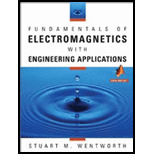
Concept explainers
Given
Want to see the full answer?
Check out a sample textbook solution
Chapter 2 Solutions
Fundamentals of Electromagnetics with Engineering Applications
- The following charges distributions are present in free space as shown in Figure, point charge 6 nC at P(2.0,6). a uniform infinite line charge density 1.5 nCm at x-2, y- 3, and infinite surface charge density 0.1 nCm atx2. the electric field at origin due to the point charge only is le charge 4.427a-1281a 475 ax ONone of Thesearrow_forwardi need the answer quicklyarrow_forwardCould you please explain it?arrow_forward
- In the figure particles 2 and 4, of charge -e, are fixed in place on a y axis, at y₂ = -8.38 cm and y4 = 4.19 cm. Particles 1 and 3, of charge - e, can be moved along the x axis. Particle 5, of charge +e, is fixed at the origin. Initially particle 1 is at x₁ = -8.38 cm and particle 3 is at x3 = 8.38 cm. (a) To what x value must particle 1 be moved to rotate the direction of the net electric force Fnet on particle 5 by 30° (b) With particle 1 fixed at its new position, to what x value must you move particle 3 to rotate back to its original counterclockwise? direction? (a) Number i (b) Number i Units Units 10arrow_forward(1) THE FOLLOWING QUESTIONS ARE BASED ON THE INFORMATION GIVEN HERE. A rod of semiconducting material of length L = 7 m and cross-sectional area A = 2.5 mm2 lies along L. The material obeys Ohm's law, and its resistivity varies along the %3D the x-axis between z = 0 and z = rod according to p= po 1 where po L? 2.5 x 10 4N. m. The end of the rod at a = 0 is at a %3D potential Vo = 40 V greater than the end at a = L. A) What is the total resistance, in units of 2, of the rod? Answer: B) What is the current, in units of miliamperes, in the rod? Answer: C) What is the electric potential, in units of Volt, in the rod at z = L/2? Answer:arrow_forwardA volume charge density is known to be Delta(n, deg, z) in cylindrical coordinates. What is the appropriate expression to evaluate the total charge (for an arbitrary geometry)arrow_forward
- Q-4: In a one-dimensional device, the charge density is given by If E=0 at x = 0 and x p(x) = Poa' V = 0 at x = a, find V and E for this device at any point 0 ≤ x ≤a. P= P₁ & II X=Garrow_forwardplease answer part C and D only. thank you ...arrow_forwardME. 3. A positive point charge q = 1.2μC is surrounded by a sphere with radius 0.7m centered on the charge. Find the electric flux through the sphere due to this charge. Select one: O a. 175163.08 Nm2/C O b. 153167.08 Nm2/C O c. 167315.80 Nm2/C Od. 135716.80 Nm2/C Clear my choice <arrow_forward
- Gauss law states that the electric flux passing through any closed surface is equal to Select one: a. the total charge outside that surface b. None of the above c. the total charge enclosed by that surface.arrow_forwardi need the answer quicklyarrow_forwardQ-4: In a one-dimensional device, the charge density is given by p(x) = po, If E=0 at x = 0 and x V = 0 at x = a, find V and E for this device at any point 0 ≤ x ≤a. & P = P₁ & ² x=0 X=Garrow_forward
 Introductory Circuit Analysis (13th Edition)Electrical EngineeringISBN:9780133923605Author:Robert L. BoylestadPublisher:PEARSON
Introductory Circuit Analysis (13th Edition)Electrical EngineeringISBN:9780133923605Author:Robert L. BoylestadPublisher:PEARSON Delmar's Standard Textbook Of ElectricityElectrical EngineeringISBN:9781337900348Author:Stephen L. HermanPublisher:Cengage Learning
Delmar's Standard Textbook Of ElectricityElectrical EngineeringISBN:9781337900348Author:Stephen L. HermanPublisher:Cengage Learning Programmable Logic ControllersElectrical EngineeringISBN:9780073373843Author:Frank D. PetruzellaPublisher:McGraw-Hill Education
Programmable Logic ControllersElectrical EngineeringISBN:9780073373843Author:Frank D. PetruzellaPublisher:McGraw-Hill Education Fundamentals of Electric CircuitsElectrical EngineeringISBN:9780078028229Author:Charles K Alexander, Matthew SadikuPublisher:McGraw-Hill Education
Fundamentals of Electric CircuitsElectrical EngineeringISBN:9780078028229Author:Charles K Alexander, Matthew SadikuPublisher:McGraw-Hill Education Electric Circuits. (11th Edition)Electrical EngineeringISBN:9780134746968Author:James W. Nilsson, Susan RiedelPublisher:PEARSON
Electric Circuits. (11th Edition)Electrical EngineeringISBN:9780134746968Author:James W. Nilsson, Susan RiedelPublisher:PEARSON Engineering ElectromagneticsElectrical EngineeringISBN:9780078028151Author:Hayt, William H. (william Hart), Jr, BUCK, John A.Publisher:Mcgraw-hill Education,
Engineering ElectromagneticsElectrical EngineeringISBN:9780078028151Author:Hayt, William H. (william Hart), Jr, BUCK, John A.Publisher:Mcgraw-hill Education,





